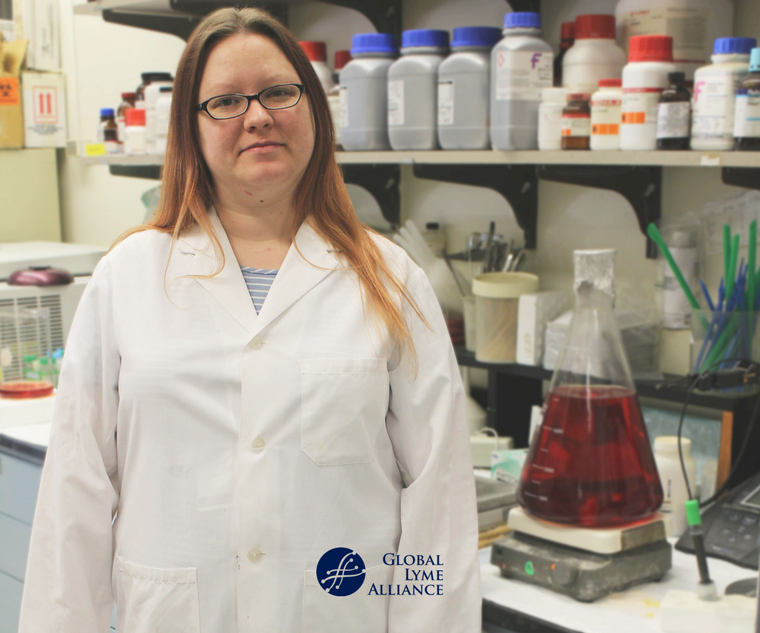
Connecticut residents are far too familiar with Lyme disease, but the ins and outs of how humans become infected is still unclear. Researchers from UConn Health set out to better understand how the causative bacterial agent of Lyme disease, Borrelia burgdorferi (Bb), survives in ticks and mammals.
While we may all know Lyme disease is transmitted between ticks and humans, how the bacteria generates disease in humans is less clear. Recently researchers from UConn Health set out to better understand how the causative bacterial agent of Lyme disease, Borrelia burgdorferi ( Bb), survives in ticks and mammals. The findings from Ashley Groshong, Ph.D., postdoctoral fellow in the UConn Health Spirochete Research Lab, and colleagues were recently published in mBio. Here’s a refresher on the typical steps involved in the spreading of Lyme disease. An infected black-legged tick ( Ixodes scapularis) feeds on and infects a mammal, like a white-footed mouse, to transmit a pathogen (i.e. Borrelia burgdorferi) to its next mammalian host. While the tick may prefer to feed from small rodents or deer, often times humans are an accidental host. In this case, transmission of the bacteria to humans results in disease pathology. This bacterial pathogen is a spirochete, which means it has a unique spiral shape, and it is slow to replicate. It also depends entirely on its host for nutrients, a unique characteristic that has drawn attention from many Lyme researchers. While previous genetic analyses have suggested that the Bb’s genome encodes a cellular transport system capable of importing nutrients from the host in the form of peptides, the importance of the system for viability and pathogenesis had never been established. “We wanted to target the energy domain of the system to understand exactly how important this system is for survival and proliferation during infection,” explains Groshong. “If we understand how B. burgdorferi acquires its nutrients from its hosts and which nutrients are essential, it could potentially lead to a novel target for therapeutic intervention.” The peptide transport system is quite complex, preventing previous evaluation of its role in the bacteria. To better understand the importance of peptides, a source of amino acids, Groshong and the UConn Health team set about using a novel approach. Groshong created a mutant version of B. burgdorferi that effectively blocks the spirochete’s normal methods of consuming peptides by targeting the lynchpin of the transporter, the part of the system that provides energy for peptide transport. The research showed that spirochetes deprived of peptides failed to replicate, which indicates that peptide uptake is essential for bacterial viability and infectivity. In other words, Groshong and the UConn Health team have shown that if Bb’s transport system is inhibited, it would be possible to block the proliferation of the bacteria in an infected mammal, such as a human or rodent. Interestingly, this is the only pathogen demonstrated to require peptides for basic viability, making this a unique find in the world of pathogenic bacteria. Lyme disease research is particularly important for Connecticut residents, where the condition was first recognized in Lyme, Connecticut in 1975. According to the Connecticut State Department of Public Health, approximately 30,000 people in the state are diagnosed with Lyme disease each year. “When it comes to helping Connecticut tackle Lyme disease, UConn is providing support on all fronts—from tick testing at the Connecticut Veterinary Medical Diagnostic Laboratory to innovative research like Dr. Groshong’s at the Spirochete Research Lab,” says Radenka Maric, PhD, vice president for research at UConn and UConn Health. “UConn’s faculty, postdoctoral fellows, and students are conducting research to find solutions to the major health challenges we face today.” Groshong plans to build upon this research through a project that will explore possible ways to target this system for the development of therapeutics and to evaluate if a limited peptide environment, such as the mammal, promotes the formation of antibiotic tolerant persister cells. This research will be made possible through support from a Blackman Fellowship from the Global Lyme Alliance. According to Groshong, there is still have a long way to go before this research could translate into a new treatment option, but she’s hopeful about what this discovery means for the study of Lyme disease. “Right now, our options for treating and preventing this infection are limited and not specific to the bacteria,” says Groshong. “Our goal is to conduct research that could lead to better understanding of how these bacteria cause disease, as well as novel and targeted approaches to new therapies.” Other UConn Health authors include Abishek Dey, Irina Bezsonova, Melissa J. Caimano, and Justin D. Radolf. (Photo: Ashley Groshong in the UCH Spirochete Lab/OVPR Photo)





-2.jpg)
